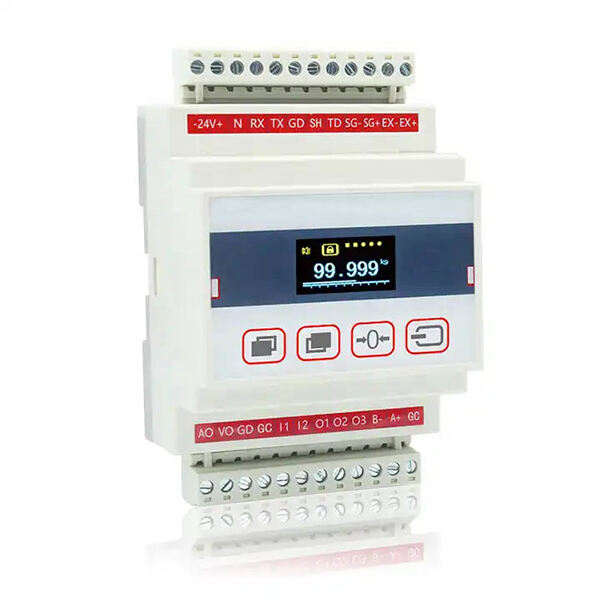What Functions Does a Load Cell Indicator Provide?
In industrial weighing systems, accuracy, reliability, and ease of use are essential for achieving efficient operations. While the Load Cell itself plays a vital role in converting mechanical force into an electrical signal, the data it produces would be meaningless without a device to process and display it. That’s where the Load Cell Indicator comes into play.
A Load Cell Indicator serves as the interface between the weighing sensor and the operator or control system. It interprets the electrical signals generated by the Load Cell, processes them into meaningful weight or force readings, and often provides additional control and communication functions. Whether in manufacturing, logistics, agriculture, or laboratory testing, the Load Cell Indicator ensures that weighing data is accurate, accessible, and actionable.
This article explores what a Load Cell Indicator is, its key functions, features to look for, and the role it plays in different industries.

Understanding What a Load Cell Indicator Is
A Load Cell Indicator, also known as a weight indicator or digital indicator, is an electronic device designed to read, process, and display the output from a Load Cell or a group of Load Cells. It is typically installed as part of a complete weighing system, which might include load cells, a junction box, cabling, and a display/control unit.
The indicator receives the millivolt signal from the Load Cell, amplifies it, converts it into a digital format, and then displays the weight reading. Modern Load Cell Indicators often come with advanced processing capabilities, communication options, and integration with automation systems.
How a Load Cell Indicator Works
Signal Reception: The Load Cell generates a small electrical signal proportional to the force or weight applied. This signal is typically in millivolts per volt (mV/V).
Signal Amplification: The Load Cell Indicator amplifies this low-level signal to a level suitable for processing.
Analog-to-Digital Conversion (ADC): The amplified signal is converted into a digital form by the ADC circuitry within the indicator.
Data Processing: The digital signal is processed using calibration parameters, filtering, and other algorithms to generate a stable and accurate weight reading.
Display and Output: The processed weight is displayed on the indicator’s screen and can be transmitted to external devices or control systems via communication ports.
Key Functions of a Load Cell Indicator
Accurate Weight Display
The most basic function of a Load Cell Indicator is to display the weight or force measurement derived from the Load Cell. This reading can be shown in various units, such as kilograms, pounds, or newtons, depending on the application.
Signal Filtering and Stabilization
Load Cells are sensitive devices, and their output can be affected by vibration, electrical noise, and environmental factors. The Load Cell Indicator applies digital filtering techniques to stabilize the reading, eliminating fluctuations and ensuring accuracy.
Calibration and Adjustment
A Load Cell Indicator allows the user to calibrate the weighing system using known test weights or calibration codes. This ensures that the readings remain precise over time and compensates for any drift in the Load Cell’s performance.
Tare Function
The tare feature lets operators set the current load as zero, ignoring the weight of containers, pallets, or fixtures. This is particularly useful in packaging, batching, and material handling.
Zero Tracking
Zero tracking ensures that the display returns to zero when the scale is unloaded, compensating for small drifts caused by environmental conditions or gradual material buildup.
Peak Hold and Average Reading
Some applications require capturing the maximum load applied (peak hold), while others need the average over a period for stability. A Load Cell Indicator can provide both functionalities.
Counting Mode
In manufacturing and inventory management, counting mode allows the Load Cell Indicator to determine the quantity of items based on their average unit weight, speeding up stocktaking and packaging processes.
Check Weighing
In quality control, check weighing compares measured weights against preset limits. The indicator can trigger alarms or lights when the weight is within, below, or above the target range.
Batching and Filling Control
Advanced Load Cell Indicators can control batching or filling operations directly by activating relays or outputs when a set weight is reached, automating the material dispensing process.
Data Logging and Storage
Some Load Cell Indicators can store weight readings, calibration data, and operational logs for later review or compliance reporting.

Communication and Integration
Modern indicators often feature multiple communication interfaces such as RS232, RS485, USB, Ethernet, CAN bus, or wireless connectivity. This allows integration with PLCs, PCs, printers, and industrial networks for process automation and data management.
Remote Display and Monitoring
Certain Load Cell Indicators can transmit weight readings to remote displays, control rooms, or cloud-based systems, enabling centralized monitoring of multiple weighing stations.
Features to Consider When Choosing a Load Cell Indicator
Display Type and Size: Bright, high-contrast displays improve visibility in various lighting conditions.
Number of Load Cell Inputs: Some indicators can handle multiple load cells directly, ideal for large platform scales or weighbridges.
Resolution and Accuracy: Choose an indicator with sufficient resolution to match the precision of your Load Cell.
Environmental Protection: For harsh environments, look for IP-rated enclosures that protect against dust, moisture, and chemicals.
Power Options: Indicators may run on AC power, DC power, or batteries for portable use.
User Interface: Easy-to-use menus, programmable keys, and multilingual support can simplify operation.
Software Compatibility: Integration with data management or ERP systems can streamline reporting and analysis.
Industrial Applications of Load Cell Indicators
Manufacturing and Production Lines
Load Cell Indicators ensure accurate weight measurement for parts, assemblies, and raw materials, supporting quality control and process efficiency.
Logistics and Warehousing
In shipping and receiving, Load Cell Indicators verify cargo weights to ensure compliance with transportation regulations.
Agriculture and Livestock Management
Indicators are used with hopper scales, silo weighing systems, and livestock scales to manage feed, inventory, and production.
Food and Beverage Processing
Accurate weight control is critical for portioning, packaging, and recipe consistency in food production.
Construction and Mining
Load Cell Indicators are used with heavy equipment and weighing systems to measure loads of aggregates, minerals, or construction materials.
Laboratory Testing
In research environments, Load Cell Indicators provide precise measurements for experiments, material testing, and product development.
Maintenance Tips for Load Cell Indicators
Keep the display clean and free from dust or moisture.
Check electrical connections regularly for corrosion or damage.
Recalibrate periodically to maintain accuracy.
Protect the indicator from excessive vibration or shock.
Ensure firmware updates are applied if the model supports them.
The Future of Load Cell Indicators
With the rise of Industry 4.0, Load Cell Indicators are evolving into smarter, more connected devices. Future developments may include:
Built-in cloud connectivity for remote monitoring and predictive maintenance.
AI-based signal analysis for real-time fault detection.
Multi-sensor integration for combined weight, temperature, and vibration monitoring.
Enhanced touch-screen interfaces with customizable dashboards.
These innovations will make Load Cell Indicators even more valuable as central hubs in industrial weighing systems.
FAQ
What is a Load Cell Indicator used for?
It processes the electrical signal from a Load Cell and displays it as a readable weight or force measurement.
Can a Load Cell Indicator connect to multiple load cells?
Yes, many models can handle inputs from several load cells, especially for large-scale platforms or weighbridges.
How does a Load Cell Indicator improve weighing accuracy?
It applies signal amplification, filtering, and calibration adjustments to ensure stable and precise readings.
Can a Load Cell Indicator be integrated with automation systems?
Yes, modern indicators support communication protocols for integration with PLCs, PCs, and industrial networks.
What is the tare function on a Load Cell Indicator?
It allows the user to set the current load as zero to exclude container or fixture weight from the measurement.
Do Load Cell Indicators store data?
Many advanced models can log weight readings, calibration settings, and operational data for future reference.
Are Load Cell Indicators suitable for harsh environments?
Yes, models with IP-rated enclosures and corrosion-resistant materials can operate reliably in tough industrial conditions.
Table of Contents
- What Functions Does a Load Cell Indicator Provide?
- Understanding What a Load Cell Indicator Is
- How a Load Cell Indicator Works
- Key Functions of a Load Cell Indicator
- Features to Consider When Choosing a Load Cell Indicator
- Industrial Applications of Load Cell Indicators
- Maintenance Tips for Load Cell Indicators
- The Future of Load Cell Indicators
-
FAQ
- What is a Load Cell Indicator used for?
- Can a Load Cell Indicator connect to multiple load cells?
- How does a Load Cell Indicator improve weighing accuracy?
- Can a Load Cell Indicator be integrated with automation systems?
- What is the tare function on a Load Cell Indicator?
- Do Load Cell Indicators store data?
- Are Load Cell Indicators suitable for harsh environments?

